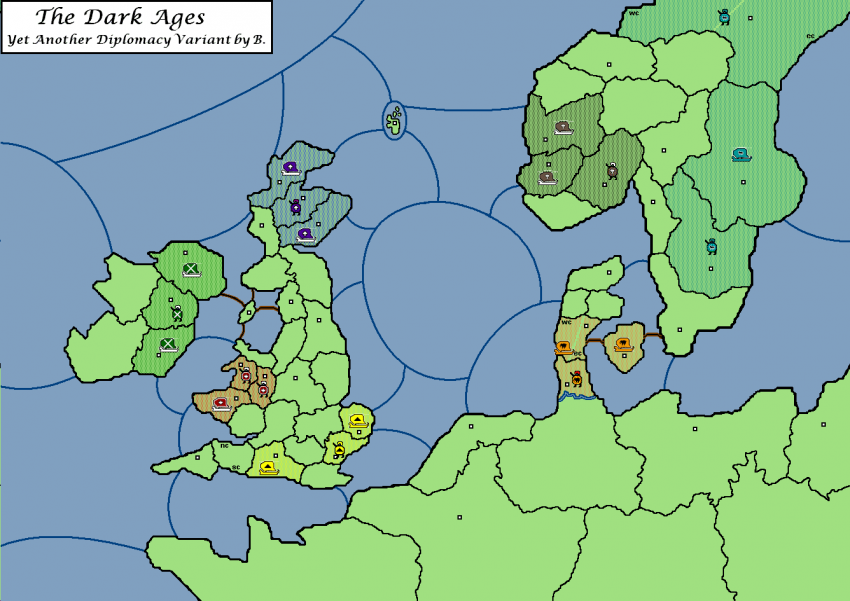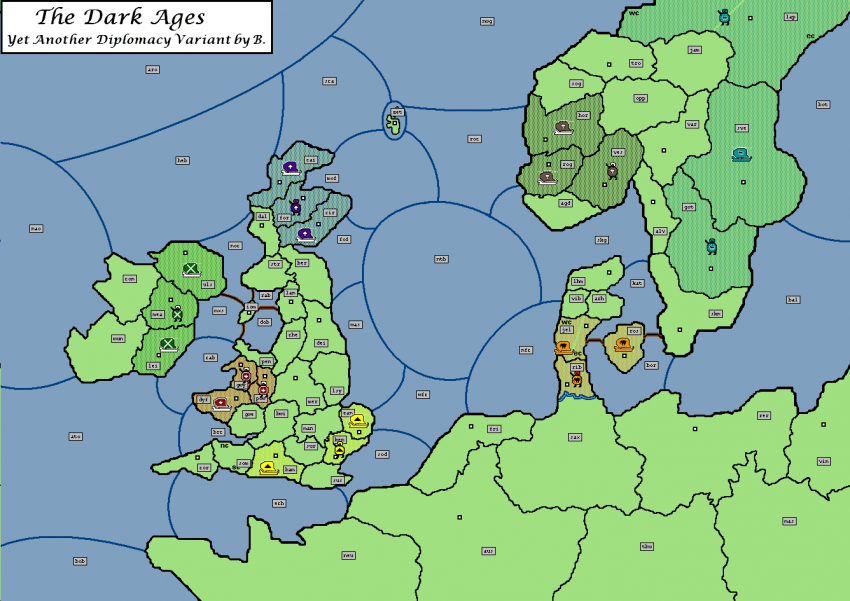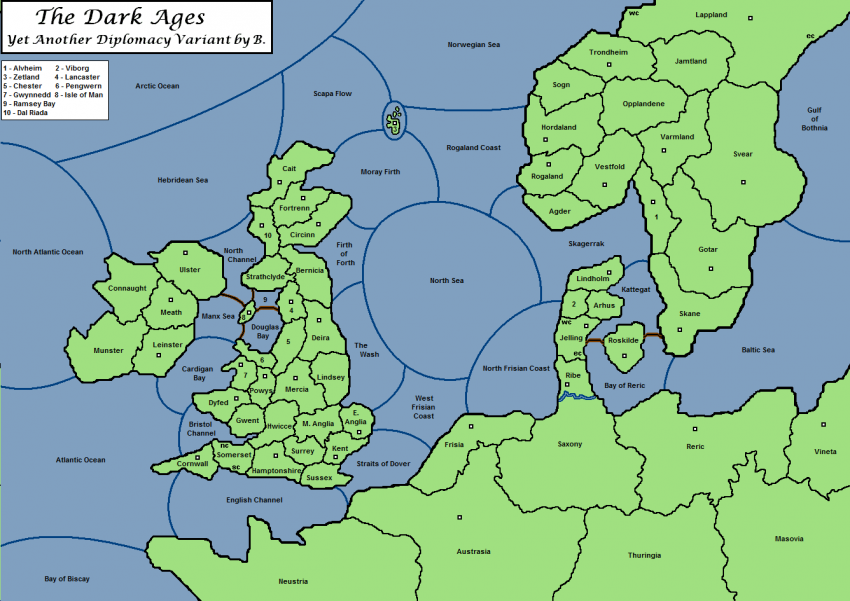Dark Ages
Variant Created by: Benjamin Hester
Starting Positions
The Gaels - Forest Green, G (in Ireland)
The Scots - Blue, C (in Scotland)
The Bretons - Crimson, B (in Wales)
The AngloSaxons - Olive, A (in southern England)
The Danes - Orange, D (in Denmark)
The Norse - Charcoal, N (in Norway)
The Swedes - Teal, S (in Sweden)
Variant Rules
Dark Ages Variant Rules, Version 4. Homepage: http://www.dipwiki.com
The Dark Ages Variant is a historical transplant of Hasbro/Avalon Hill's Diplomacy game to the North Sea region in 825 AD.
The Dark Ages variant conforms to the standard rules of Hasbro/Avalon Hill's Diplomacy in most every way, with the few exceptions listed below. The standard rules are NOT copied here, and all players of the Dark Ages Variant are assumed to own or expected to purchase the Rules of Diplomacy (or better yet, the full game) through Hasbro/AH, as I did.
Turns move from Spring to Fall just like standard Diplomacy, and the first turn is Spring 825 AD. Players take control of one of the seven major nations in the North Sea area, the Gaels, Scots, Britons, Anglo-Saxons, Danes, Norse, or Swedes.
Please check the names feature of Realpolitik for accepted abbreviations of territory names.
Special territories:
Somerset, Jelling and Lappland are bi-coastal territories, similar to Spain or Bulgaria in Standard.
The Island of Man and Roskilde are similar to Constantinople in Standard in most respects. Armies and Fleets may move directly from Jelling, to Roskilde, to Skane, and vice versa. This is indicated on the map with the brown and black "bridges." Unlike Constantinople though, Fleets MAY move directly from Kattegat to Bay of Reric (and vice versa) - they may move around Roskilde. A fleet in Roskilde may NOT convoy. The Isle of Man functions in a similar manner, as do the sea zones around it.
Zetland is a single land SC depicted on the map as an island group. Everything inside the small blue circle is a single space, i.e. the four small islands and the small amount of water around them are all one space (similar to Cebu in Colonial). Zetland is bordered at sea by Scapa Flow, Norwegian Sea, Rogaland Coast, and Moray Firth. It is not adjacent by land to any other territory, though Zetland may be occupied by an army (via convoy) or by a fleet.
Finally, the Eider River, which forms the border between Ribe and Saxony, is navigable by fleets. This means that a fleet in Ribe or a fleet in Saxony may move to either the North Frisian Coast, or the Bay of Reric. These two sea zones are *not* adjacent to one another - i.e. a fleet in Bay of Reric must first travel to either Ribe or Saxony, and then on to North Frisian Coast in the following turn. Neither Ribe or Saxony is bi-coastal.
There are 37 total SCs on the map. Solo victory is declared when one nation has control of 19 SCs (simple majority). Have fun and happy raiding!
Commentary
The Dark Ages variant was released in late 2007 as part of my relentless quest to become the most prolific variant designer around. (I only have three others completed, so I’m sure I have a ways to go before I can claim that title.) Since that time, the variant has undergone three playtests (in ACD and DC) and four revisions.
Dark Ages is a simple map translation variant – meaning none of the core rules of Diplomacy have changed at all, only the map and the roles that the players assume. Which, in the case of Dark Ages, are the Gaels, Scots, Bretons, Anglo-Saxons, Danes, Norse, and Swedes, roughly as they were in the year of our Lord, 825. Some concessions to gameplay at the expense of historical accuracy have been made, but these have been limited to the greatest extent possible. The layout of the North Sea region lends itself readily to the intent of the variant – to emphasize naval action and fill the map with opportunities for convoys. This is the age of Viking and Germanic invasions by sea, and the variant is designed to capture that spirit.
The next section of this article will provide the first-time player of Dark Ages (which encompasses 99.9+% of the human race) with a brief overview of the variant and its opening strategies.
- The Gaels -
The Gaelic position is most similar to Britain in Standard. The Gaels begin fairly secure in their island home that we know today as Ireland. While they enjoy considerable defensive advantages, their early opportunities for expansion are somewhat less than their immediate neighbours.
The Isle of Man, Lancaster, and Cornwall are their most likely targets for growth in the first year. The Gaels priorities for negotiations are fairly straightforward – form a strong bond with either the Scots or Bretons early, keeping options with the Anglo-Saxons open. Avoid the formation of a Scot/Breton alliance at all costs – the Anglo-Saxons are unlikely to be able to save the Gaels in that situation, especially if they are distracted by the Danes.
- The Scots –
The Scottish position is most similar to Germany in Standard. The Scots begin the game poised for rapid expansion, but will have to make concessions to their neighbors in order to secure their vulnerabilities on three fronts. Early occupation of key sea zones may carry a short-term cost in SCs, but will pay off as a deterrent to invasion from Scandinavia, and provide opportunities to gain diplomatic capital by offering support to Norse or Danish forces. Alliances with the Gaels, Bretons, or Anglo-Saxons are all strong options in the early game, though the Scot player in particular must keep a nervous eye turned east as events unfold in Scandinavia. Events in the British Isles and Scandinavia tend to resolve themselves independent of one another in the first 2-3 years, but after that, attacks across the North Sea become more common. The Scots would do well to be the first one to occupy the strategically invaluable North Sea and Zetland Islands accordingly.
- The Bretons –
The Breton position is most similar to Austria in Standard. The Bretons have a tight group of home SCs that are all interconnected, and their position lies in a veritable minefield of SCs. Just beyond that perimeter however, lie Gaels, Scots, and Anglo-Saxons – all three potential strong allies or formidable enemies. The Bretons must tread carefully – peace on one, preferably two, fronts is a must. To that end, SCs such as Deira and Lancaster must be weighed carefully – are they more valuable in Breton hands, or traded away for friendship with a neighbor? An opening stab to Hwicce that threatens Hamptonshire can damage Anglo-Saxon growth tremendously – but are you *sure* that the Gaels will stay by your side? Of all positions in Dark Ages, the Bretons offer the most reward for well-timed stabs.
- The Anglo-Saxons –
The Anglo-Saxon position is most similar to Italy in Standard. Peaceful neutral expansion is readily available, and first year growth of 2 SCs can be attained without violating neutrality – but not without opening up vulnerabilities in your home SCs. Breton invasion of Hwicce and Middle Anglia are significant threats in the first and second years – if their attacks are coordinated with the Gaels or Danes these threats have the potential for early Anglo-Saxon elimination. Gaelic convoys into Cornwall can potentially coordinate with Breton attacks on Hamptonshire. Although dangerous, Breton/Scot alliances are usually directed more at the Gaels than the Anglo-Saxons, and should be encouraged. Breton/Gaelic alliances should be disrupted at all costs. Finally, despite the threat they pose, the Bretons can also be extremely valuable as an ally against either the Gaels or the Scots – or both.
- The Danes –
The Danish position does not have much similarity to any position in Standard. The Danes are unquestionably a naval power with considerable prospects in both directions on the European coast, as well as at the expense of their neighbors in Scandinavia. The Danes form one point of the “Scandinavian Triangle” of the Norse, Swedes, and Danes. Typically, two of these will ally against the third, and barring significant involvement from the west, that third power will be eliminated early. It is very much in the Scots and Anglo-Saxons interests to prevent this from happening however, and it is not at all uncommon for a Scot or Anglo-Saxon fleet in the North Sea to prop up Danish or Norse defenses to that end.
- The Norse –
The Norse position also bears little similarity to any position in Standard – Turkey is the closest match, but that is mostly due to their relationship with the Swedes. The Norse have a simple choice of alliance with the Danes or Swedes, while remaining vigiliant against Scottish fleets heading east. This choice also entails whether the Norse will be primarily a naval power (as is the case in most alliances with the Swedes) or if they will fight on land for dominance of Scandinavia (which is the direction most alliances with the Danes lead to.) The Norse are the second point of the Scandinavian Triangle. Of the three, they are the most vulnerable to attack from the west, typically by Scots that got off to a good start. To that end, they usually have the most interest in a rapid resolution of events in the Scandinavian Triangle, which allows them to take the initiative against the powers of the British Isles.
- And finally, the Swedes –
The Swedes are the third point of the Scandinavian Triangle. Their position bears many similarities to Russia in Standard, most notably in bi-coastal Lappland. They have ample early opportunities for expansion, though most of them will be contested by the Danes or Norse. Tension runs particularly high in Varmland and Skane, and a wise Swede will guard these territories jealously due to their tactical value. The Swedish rear guard is very secure from attack, however, an alliance of Norse and Danes can launch a devastating pincer attack that can quickly reduce the Swedes. The Swedes stand to gain the most from western involvement in Scandinavian affairs in the long term, despite the inability of those powers to directly aid Swedish defenses against an attack by the Norse and Danes. The Swedes must focus more than any other power on the control of territory with tactical value rather than simply gaining SCs.
I hope this quick overview of opening strategies for the Dark Ages has piqued your interest in the variant, and whetted your appetite to pillage and plunder in the cold northern waters. Any prospective GMs or interested players that would like more information or files for running the variant should contact me directly at Screwtape777 AT gmail DOT com. Please respect privacy and limit the distribution and use of this address to Diplomacy related topics only.
Thanks!
Your humble variant designer – B.


